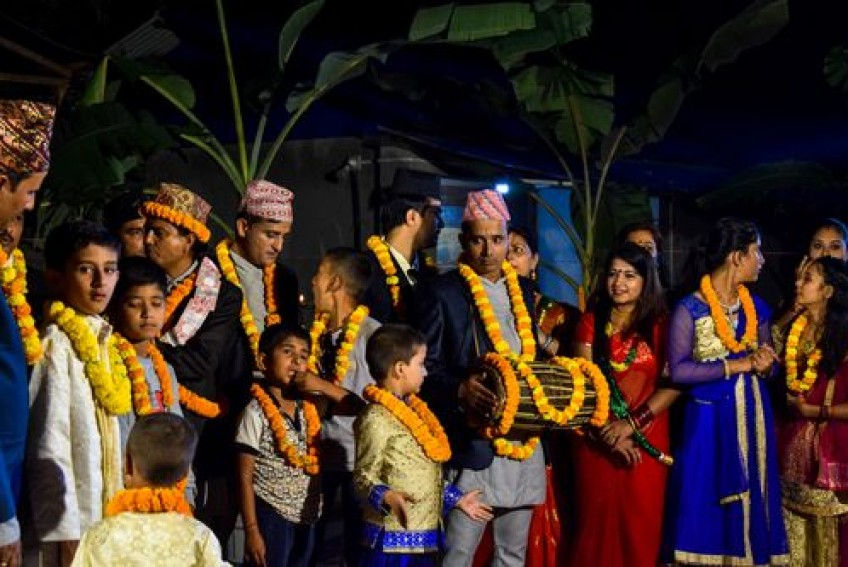
The Tihar festival, a part of which is also known as Diwali in India, is celebrated religiously in the Darjeeling hills. This festival consists of several pujas, celebrations and rituals. However, the most prominent of all is the Deusi and Bhailo tradition. Beginning from the third day of the Tihar, people across all ages form groups and visit their friend’s, relative’s and neighbour’s houses, singing and dancing to traditional songs and tunes. The performance ends with a benediction sung by the troupe and the hosts expressing their gratitude in the form of monetary gifts.
The Deusi and Bhailo tradition is practiced not only in Darjeeling but also in several parts of the Himalayan region including Nepal, Bhutan, Sikkim, Uttarakhand and Himachal Pradesh. Being several decades old, this tradition is deeply embedded in the culture of Darjeeling and its sheer richness speaks well for its future. Bhailo is performed by the young girls and women, and Deusi by the boys and men. It is interesting to note that in recent times, many young girls have started to take part even in the Deusi performances. The most probable reason is that bhailo is performed only on the night of Laxmi puja while Deusi can go on for several days and nights! A performance by one group can last anywhere between 15mins to half an hour in one house after which the group moves to another. The performers, in return are showered with blessings from the elderly and are offered money, flowers and even food and drinks.
On the origin of the Deusi-Bhailo tradition:
There and several legends, myths as well as debates surrounding the origin of the Deusi-Bhailo tradition. While we might never be able to get to authenticate any story, here are some frequently surfacing beliefs:
First: The tradition, it is believed can be traced to medieval Nepal and is linked to the ruler of Jumla province - King Bali. It his believed that his mother had entered Nepal from Kashmir. According to mythology, a learned pilgrim found Bali as worthy of becoming the ruler and declared him the king of the village named Kallai. Bali was an able ruler and was loved by people in his kingdom. The Das-Dasi pratha or the slavery system was prevalent is Nepal during those days. King Bali was known for his generosity and kindness. On the day of Laxmi puja, he allowed his servants to go out of his palace, visiting houses in his kingdom. He even issued an order that on the day of Laxmi Puja, the Devdasas and Devdasis be respected an offered money and food. This is how the tradition came into being.
Second: According to the second prominent story, Bali was an asura king (king of demons) of Kirat. Bali, a loyal worshipper of Lord Vishnu, had become the mightiest king who controlled all the three loks or worlds - Heaven, Earth and Hell. The Gods were against his supremacy and therefore urged Lord Vishnu to send him to Paatal Lok forever. Agreeing with the Gods, Bali was sent to hell by Lord Vishnu. In return, Bali demanded that he should be allowed to come to the earth at least for a few days. Lord vishnu accepted his demands and thus allowed him to come and visit the Earth for five days during the Yama Panchak. Those loyal to King Bali in the Earth would go from door to door, spreading the news that Bali would be visiting their homes soon and urging them to prepare for it. This was in the form of songs and dances of celebration thus marking the beginning of the Deusi-Bhailo tradition. There is another interesting myth interwoven here - Bali was extremely wealthy, therefore in order to save their honour and make their world seem prosperous, the Gods brightened their world by lighting lamps and diyas. This is believed, by many, to be the reason why Diwali, as celebrated in the hills, is considered to be the festival of lights. The practice of lighting diyas is a symbolic enactment, remembering these Gods and Goddesses.
Third: The third story is linked to the Asura King Bali who, like his father Pralad, was an ardent worshipper of Lord Vishnu who blessed him immensely. Bali was extremely powerful and was once performing a yagnya (ritual) which would help him acquire ultimate power like no other ruler. But knowing his lineage to demons, Lord Vishnu disguised as a small child, visited Bali’s world. Being aware about the generous nature of the king, Lord Vishnu asked Bali if he would grant him anything he wished for. Bali asked what the child wanted. Lord Vishnu wished the land that his three steps would cover. Considering that it wasn’t a huge wish, Bali immediately agreed. At that moment, Lord Vishnu emerged in his real form. With one step he covered the heavens, with another he covered the hell. Since there was no place left for the third step, abiding by his promise, King Bali requested Lord Vishnu to place his foot on the his head. Hence, it is believed that the word ‘Deusi’ is derived from the Nepali word ‘Deu Sire' where ‘deu’ translates to ‘give’ and ‘sire’ meaning ‘head’. As mentioned earlier, it is impossible to trace the exact origin of the Deusi-Bhailo tradition. But, whatever be the real story, it definitely is a beautiful way of strengthening the bond among people in the Himalayan regions, including the Darjeeling Hills.
.png)
Комментарии